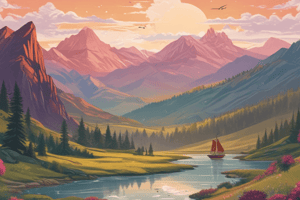Podcast
Questions and Answers
What is the main focus of population ecology?
What is the main focus of population ecology?
- The impact of environmental changes on habitats
- The dynamics of populations within a specific area (correct)
- The interaction between different communities
- The study of species diversity in ecosystems
Which of the following best describes a 'population' in human demography?
Which of the following best describes a 'population' in human demography?
- A diverse group of species interacting within an ecosystem
- Individuals of different species cohabiting a single environment
- All humans on the planet regardless of location
- A set of individuals living in a specific area (correct)
What factor does NOT typically affect population growth?
What factor does NOT typically affect population growth?
- Climate stability
- Availability of resources
- Human technological advancement (correct)
- Predation pressure
What is an example of a population as defined in population ecology?
What is an example of a population as defined in population ecology?
What is the significance of studying population dynamics?
What is the significance of studying population dynamics?
What is an example of a true predator?
What is an example of a true predator?
Which type of resource partitioning involves using the same resource at different times?
Which type of resource partitioning involves using the same resource at different times?
Which statement best describes mutualism?
Which statement best describes mutualism?
What is the competitive exclusion principle?
What is the competitive exclusion principle?
What type of resource partitioning explains the use of different physical locations?
What type of resource partitioning explains the use of different physical locations?
Which of the following is a characteristic of parasites?
Which of the following is a characteristic of parasites?
What effect does removing a keystone species have on an ecosystem?
What effect does removing a keystone species have on an ecosystem?
What is ecological succession?
What is ecological succession?
What is the primary focus of Community Ecology?
What is the primary focus of Community Ecology?
Which of the following best describes competition in ecological terms?
Which of the following best describes competition in ecological terms?
In the context of exploitation interactions, which scenario is an example of herbivory?
In the context of exploitation interactions, which scenario is an example of herbivory?
Which of the following is an example of mutualism?
Which of the following is an example of mutualism?
What type of interaction occurs when one species feeds on another species and harms it?
What type of interaction occurs when one species feeds on another species and harms it?
What is the outcome of commensalism?
What is the outcome of commensalism?
Which of the following interactions is characterized by both species benefiting?
Which of the following interactions is characterized by both species benefiting?
What describes the interaction in which a predator kills and consumes its prey?
What describes the interaction in which a predator kills and consumes its prey?
What is the primary difference between density-dependent and density-independent factors influencing population size?
What is the primary difference between density-dependent and density-independent factors influencing population size?
In which type of survivorship curve would you expect to find species such as mosquitoes and dandelions?
In which type of survivorship curve would you expect to find species such as mosquitoes and dandelions?
What characterizes K-selected species compared to r-selected species?
What characterizes K-selected species compared to r-selected species?
What defines a metapopulation?
What defines a metapopulation?
What is the main feature of the logistic growth model?
What is the main feature of the logistic growth model?
Which characteristic is typically true for populations with large numbers of young individuals?
Which characteristic is typically true for populations with large numbers of young individuals?
How does population density help in understanding a species in a particular area?
How does population density help in understanding a species in a particular area?
What occurs during population overshoot and die-off in ecological terms?
What occurs during population overshoot and die-off in ecological terms?
What is the population sex ratio typically found in most species?
What is the population sex ratio typically found in most species?
Which option best describes the impact of immigration on population size?
Which option best describes the impact of immigration on population size?
What is the primary characteristic that distinguishes primary succession from secondary succession?
What is the primary characteristic that distinguishes primary succession from secondary succession?
What role do pioneer species play in ecological succession?
What role do pioneer species play in ecological succession?
How does species richness differ from relative abundance in a community?
How does species richness differ from relative abundance in a community?
Which of the following best describes a climax community?
Which of the following best describes a climax community?
In the given examples of forest communities, which metric indicates a more diverse community?
In the given examples of forest communities, which metric indicates a more diverse community?
What would be the relative abundance of species B in Community 2?
What would be the relative abundance of species B in Community 2?
Which of the following factors is NOT part of the Shannon diversity index (H) calculation?
Which of the following factors is NOT part of the Shannon diversity index (H) calculation?
Which of the following statements about species diversity is accurate?
Which of the following statements about species diversity is accurate?
Flashcards are hidden until you start studying
Study Notes
Population Ecology
- Population is a group of individuals of the same species living in a particular area at the same time.
- Population Ecology focuses on understanding how populations grow, shrink, and interact with their environment.
- Levels of complexity in ecology: Individual/Organism, Population, Community, Ecosystem, Biosphere.
- Basic population characteristics include:
- Population size (N) - total number of individuals in a population.
- Population density - number of individuals per unit area, indicating if a species is rare or abundant.
- Population distribution - how individuals are spaced relative to each other:
- Random - no pattern (trees in a forest).
- Uniform - fairly even spacing (nesting birds).
- Clumped - individuals gather together (schooling fish).
- Population sex ratio - ratio of males to females, usually 50:50, crucial for population growth.
- Population age structure - number of individuals in each age category, determining if a population is increasing (large number of young) or decreasing (large number of old).
Factors Influencing Population Size
- Density-dependent factors affect survival based on population size:
- Limiting resources like food influence an individual's odds of survival based on population size.
- Carrying capacity is the maximum population an ecosystem can support due to resource availability.
- Density-independent factors have the same effect regardless of population size:
- Natural disasters like tornadoes can impact survival irrespective of population size.
Population Growth Models
- Exponential growth model - ideal conditions with unlimited resources, resulting in a J-shaped curve.
- Intrinsic growth rate is the maximum growth rate for a species under ideal conditions.
- Logistic growth model - considers environmental limits on growth, resulting in an S-shaped curve.
- Carrying capacity limits growth as resources become scarce.
Reproductive Strategies
- K-selected species have:
- Low intrinsic growth rate.
- Slow population growth.
- Large body size.
- Late maturity.
- Few offspring.
- Substantial parental care.
- r-selected species have:
- High intrinsic growth rate.
- Fast population growth.
- Small body size.
- Early maturity.
- Many offspring.
- Little or no parental care.
Survivorship Curves
- Type I - high survival throughout life (K-selected species: humans, elephants).
- Type III - low survival early in life, few reach adulthood (r-selected species: mosquitoes, dandelions).
- Type II - constant decline in survivorship throughout life (squirrels, coral).
Metapopulations
- Metapopulations are fragmented parts of a larger population.
- Movement between metapopulations reduces extinction risk by increasing genetic diversity and population size.
Community Ecology
- Community - all populations of different species living together in a particular area.
- Community Ecology studies the organization and functioning of communities and their interactions.
Interspecific Interactions
- Competition (-/-) - two species compete for a limited resource.
- Exploitation (+/-) - one species benefits by consuming another:
- Predation - predator kills and eats prey.
- Herbivory - herbivore eats part of a plant.
- Parasitism - parasite derives nourishment from its host.
- Positive Interactions (+/+ or 0/+) - one species benefits, while the other either benefits or is not harmed:
- Mutualism (+/+) - both species benefit.
- Commensalism (+/0) - one species benefits, the other is unaffected.
Competition
- Competitive exclusion principal - two species competing for the same limiting resource cannot coexist.
- Resource partitioning - two species divide the resource based on behavior or morphology, leading to evolution:
- Temporal resource partitioning - using the same resource at different times.
- Spatial resource partitioning - using different locations.
- Morphological resource partitioning - evolving different body plans to use different parts of the resource.
Mutualism
- Mutualism - two species interact to increase survivability for both.
- Examples: Plants and pollinating insects, acacia trees and ants.
Commensalism
- Commensalism - one species benefits while the other is not affected.
- Examples: Birds nesting in trees.
Keystone Species
- Keystone species are vital for ecosystem stability, their removal leads to instability.
- Examples:
- Food supply species.
- Predator-mediated competition - predators control populations of superior competitors.
- Ecosystem engineers - create habitat for other species.
- Examples:
Changes in Communities over Time
- Ecological succession - predictable replacement of one group of species by another.
- Primary succession - occurs on surfaces without soil, like new volcanic areas.
- Secondary succession - occurs in disturbed areas with soil, like after a fire.
- Pioneer species - early colonists that grow rapidly and need lots of sunlight.
- Climax community - the later stages of succession, considered the typical community for that biome.
Species Diversity
- Species diversity is the variety of species in a community, with two components:
- Species richness - the number of different species.
- Relative abundance - the total number of individuals of a species relative to the total number of individuals of all species.
- Shannon diversity index (H) is a widely used tool to measure species diversity, with higher values indicating higher diversity.
Studying That Suits You
Use AI to generate personalized quizzes and flashcards to suit your learning preferences.




